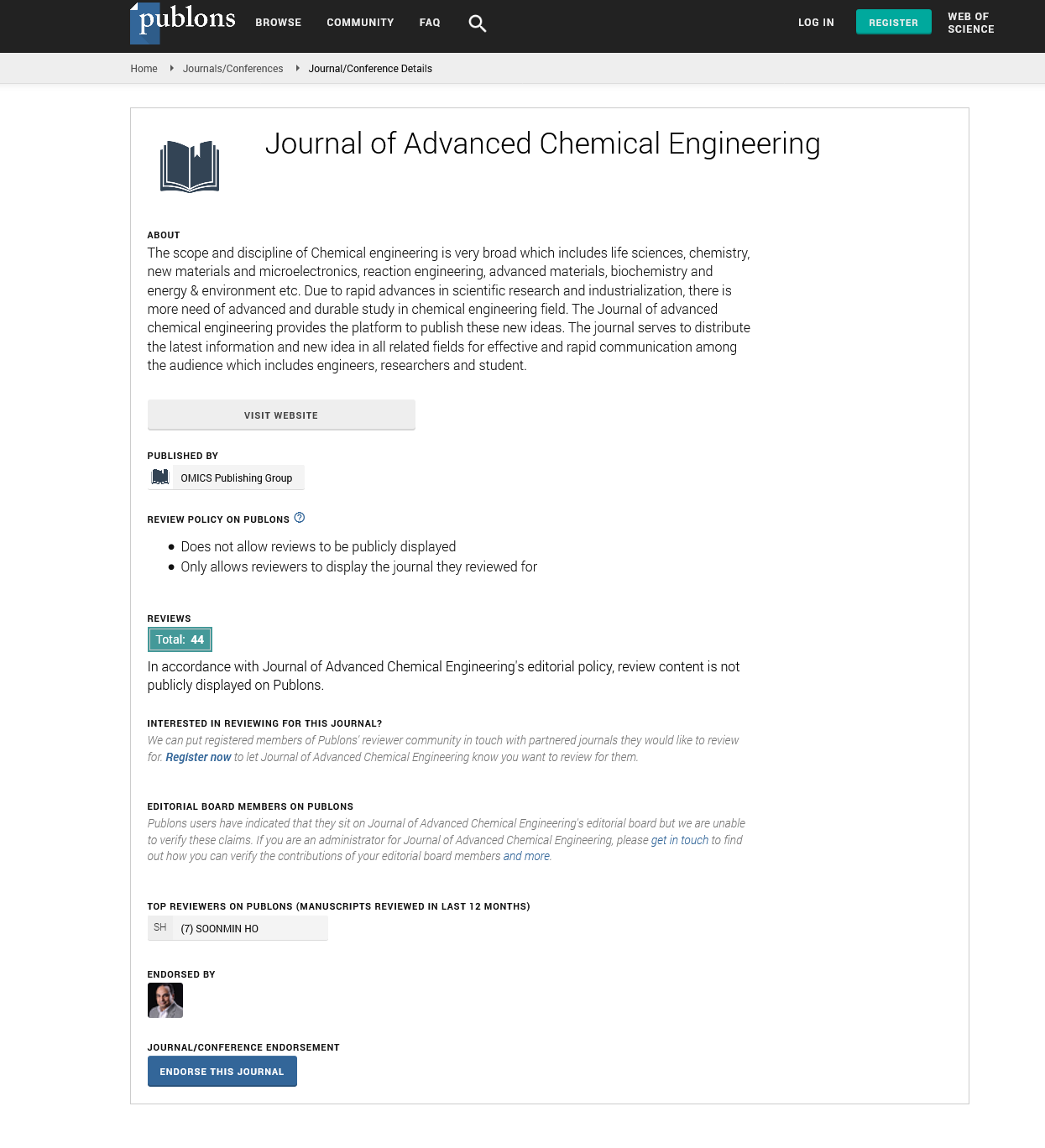Indexed In
- Open J Gate
- Genamics JournalSeek
- Smithers Rapra
- RefSeek
- Directory of Research Journal Indexing (DRJI)
- Hamdard University
- EBSCO A-Z
- OCLC- WorldCat
- Scholarsteer
- Publons
- Geneva Foundation for Medical Education and Research
- Google Scholar
Useful Links
Share This Page
Journal Flyer

Open Access Journals
- Agri and Aquaculture
- Biochemistry
- Bioinformatics & Systems Biology
- Business & Management
- Chemistry
- Clinical Sciences
- Engineering
- Food & Nutrition
- General Science
- Genetics & Molecular Biology
- Immunology & Microbiology
- Medical Sciences
- Neuroscience & Psychology
- Nursing & Health Care
- Pharmaceutical Sciences
Perspective - (2022) Volume 12, Issue 6
History of Petroleum Refining and its Future Development
Raquel Pontes*Received: 16-May-2022, Manuscript No. ACE-22-17053; Editor assigned: 19-May-2022, Pre QC No. ACE-22-17053 (PQ); Reviewed: 08-Jun-2022, QC No. ACE-22-17053; Revised: 14-Jun-2022, Manuscript No. ACE-22-17053 (R); Published: 20-Jun-2022, DOI: 10. 35248/2090-4568.22.12.231
Description
Petroleum refining or oil refinery is the chemical engineering processes that facilities the petroleum to transform crude oil into useful products such as Liquefied Petroleum Gas (LPG), gasoline or petrol, kerosene, jet fuel, diesel oil and fuel oils. The refinery is a very large industrial zone and includes various processing units and auxiliary equipment such as supply units and storage tanks.
Each refinery has its own combination of refinery layouts and processes. Some modern refineries process 800,000,900,000 barrels of crude oil per day. An integrated team of geoscientists, economists, surface engineers, and environmental engineers worked to capture these unconventional oils and gases. Public opinion continues these techniques, such as hydraulic fracturing. Crude oil is a multi-component mixture consisting of over 108 compounds. It refers to both the separation and reaction processes to obtain a variety of valuable products. Therefore, an important issue in petroleum refining is how to manage the multi-component supply stream and the multi-component product stream. Early refineries used a simple distiller or "distiller" to heat the crude oil mixture in the container and condense the resulting vapor into a liquid distillate to separate the various components of petroleum. The main product was initially kerosene, which is richer than whale oil and animal fat, has proven to be more stable in quality.
They are four types of refineries
i. Topping
ii. Hydro-skimming, and
iii. Conversion
iv. Deep conversion refineries
The single most important commodity in the world is currently primary source of energy production. Today, the world's economy is largely dependent on fossil fuels such as crude oil and small number of countries controls the largest reservoirs.
They supply and demand heavy prices for profitability of crude oil like United States, Saudi Arabia, and Russia are the leading producers of oil in the world.
Technologies applicable to the petroleum industry include:
• Waste heat process chiller
• Fouling minimization
• Robotics inspection system
• Force Internal Recirculation (FIR) burner
• Radiation stabilized burner
• Low-Profile Fluid Catalytic Converter (FCC)
• Computational fluid dynamic model
• Gas imaging for leak detection
• Advanced process analysis for refining
Economists and experts predict the path of crude oil prices, which are volatile and depend on many variables. These five models have been used most often, that are:
Oil futures prices
Central banks and the International Monetary Fund (IMF) primarily use oil futures contract prices as benchmarks. Crude oil traders set prices based on two factors: supply and demand and market sentiment.
Regression-based structural model
Statistical computer programs calculate the probability of a particular action against oil prices.
Time-series analysis
Some economists use time-series models, such as exponential smoothing models and autoregressive models, which include categories of ARIMA and ARCH/GARCH.
Bayesian models
The standard regression-based model is by adding calculations to gauge the probability of the impact of certain predicted events on oil.
Dynamic stochastic general equilibrium graphs
Dynamic Stochastic General Equilibrium (DSGE) models use macroeconomic principles to explain complex economic phenomena.
Conclusion
Petroleum engineers need to solve the various technical, political, and economic problems that arise in these missions.They need to develop and apply new techniques for extracting hydrocarbons from oil shale and offshore gas fields. These challenges provide oil engineers with a rewarding career. If the futures price is higher than the spot price, it means that the buyer expects the market to improve and is willing to pay a premium for oil delivered. If the future price is lower than the spot price, it means that the buyer expects the market to deteriorate.
Citation: Pontes R (2022) History of Petroleum Refining and its Future Development. Adv Chem Eng. 12:231.
Copyright: © 2022 Pontes R. This is an open-access article distributed under the terms of the Creative Commons Attribution License, which permits unrestricted use, distribution, and reproduction in any medium, provided the original author and source are credited.

